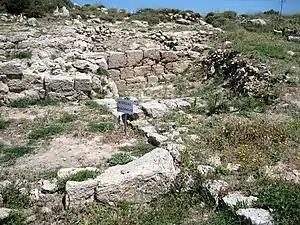Sybrita
Sybrita (Ancient Greek: Σύβριτα),[1] or Subrita or Soubrita (Σούβριτα),[2] or Subritus or Soubritos (Σούβριτος),[3] or Sibyrtus or Sibyrtos (Σίβυρτος),[4] was a town of ancient Crete, 8 M. P. from Eleutherna,[5] and famous for its numerous and beautiful silver coins, which, though some of them belong to a very early period, are fine specimens of a Cretan mint; the types are always connected with the worship of Dionysus or Hermes.[6]

It was the seat of a bishop; no longer a residential bishop, under the name Subrita it remains a titular see of the Roman Catholic Church.[7]
References
- Periplus of Pseudo-Scylax 47
- Ptolemy. The Geography. Vol. 3.17.10.
- Hierocles. Synecdemus.
- Polybius ap. Stephanus of Byzantium. Ethnica. Vol. s.v.
- Peut. Tab.
- Eckhel, Doctrina numorum veterum, vol. ii. p. 320.
- "Subrita (Titular See) [Catholic-Hierarchy]".
- Richard Talbert, ed. (2000). Barrington Atlas of the Greek and Roman World. Princeton University Press. p. 60, and directory notes accompanying.
- Lund University. Digital Atlas of the Roman Empire.
![]() This article incorporates text from a publication now in the public domain: Smith, William, ed. (1854–1857). "Sybrita". Dictionary of Greek and Roman Geography. London: John Murray.
This article incorporates text from a publication now in the public domain: Smith, William, ed. (1854–1857). "Sybrita". Dictionary of Greek and Roman Geography. London: John Murray.